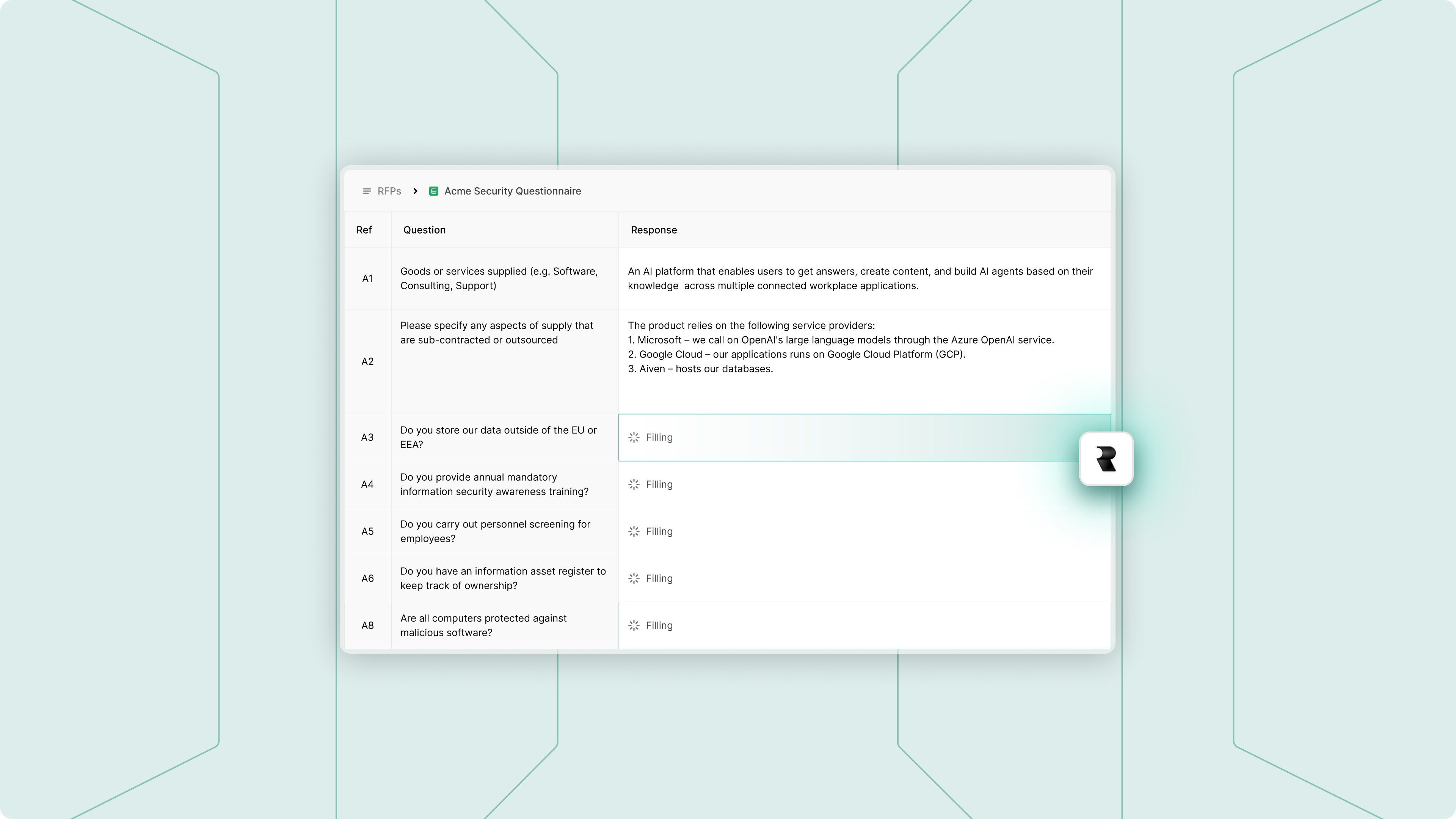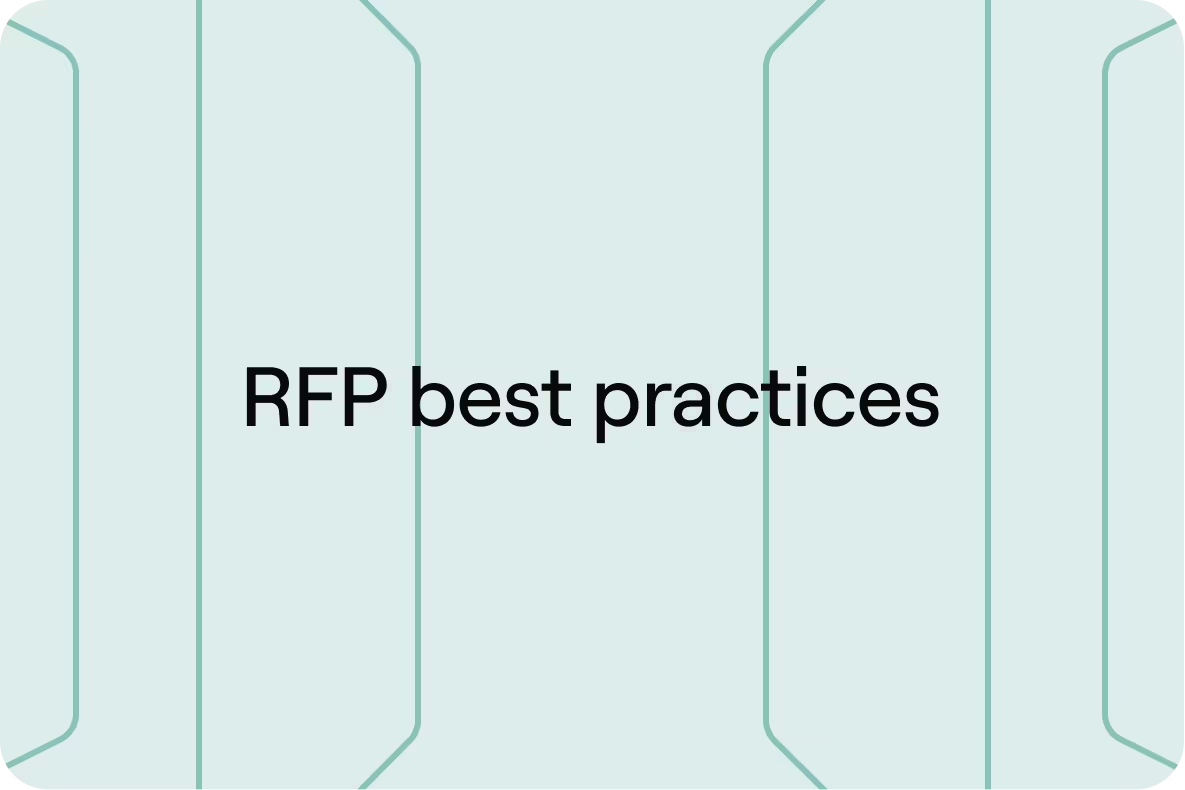Every revenue leader knows the pain: your team spends weeks wrestling with RFPs, only to see your win rate stuck in neutral. Meanwhile, your competitors seem to breeze through, landing deals with responses that feel both effortless and laser-targeted. What's their secret? They've mastered RFP best practices, both in crafting responses that win and building processes that scale. This guide is your blueprint for both: actionable, field-tested advice for winning more RFPs and building a process that won't burn out your team.
Why RFP best practices matter
Bad RFP practices don't just waste time. They bleed revenue, erode credibility, and can quietly sabotage your market position. Consider this: 47% of companies handle 10-25 RFPs monthly, and high-performers manage over 25. For many B2B organizations, RFPs influence 30-40% of total revenue. Yet too often, teams treat RFPs as bureaucratic chores, churning out generic, poorly structured responses that signal disorganization to buyers.
Without standardized rfp process best practices, teams reinvent the wheel with every new RFP. Poor qualification means you're burning resources on deals you'll never win. I've reviewed hundreds of RFPs over the years. The ones that lose? They answer what was asked, but never show why it matters to that specific buyer. The winners? They make the buyer feel understood, and make the decision to choose you feel inevitable.
RFP response best practices: A section-by-section guide

Every section of your RFP response serves a strategic purpose. Here's how to make each one count.
RFP cover letter
Your cover letter is your first impression. Make it warm, specific, and customer-focused. Show you understand what matters to the buyer by restating their objectives in your own words. Connect their challenges directly to your solution. Avoid generic pleasantries like "We are pleased to submit…" Instead, try something like: "Your goal of reducing vendor onboarding time by 40% aligns perfectly with our implementation methodology, which has helped 15 similar organizations achieve that benchmark." Keep it under one page.
Executive summary
The executive summary is often the only section every decision-maker reads. Make it count. Frontload your value proposition in the first two sentences. Structure it as: Problem you're solving → Your approach → Expected outcomes. Include 2-3 quantified benefits specific to their situation, and reference their evaluation criteria explicitly.
At Realm, our executive summaries follow a formula: we restate the buyer's top three challenges, map each to a specific capability, then close with a metric they care about: time-to-value, cost reduction, or risk mitigation. This approach has increased our read-through rate significantly. Keep it to 300-500 words maximum, or about one page.
Project implementation plan and schedule
Buyers want to see a clear, realistic path from signature to value realization. Outline milestones, timelines, and the typical journey from contract to go-live. Use their provided timeline as your anchor point. Introduce the team members they'll work with; names, roles, and experience. State clearly what you need from their side (documentation, system access, training input).
Include a visual timeline if possible, and address common roadblocks proactively: "If stakeholder interviews are delayed, here's how we'll adjust…" The more concrete and collaborative, the more confidence you build. For example, break down a 90-day implementation into three phases with specific deliverables.
Contract terms and ongoing support
Anticipate concerns before they're raised. Show you're invested in long-term success, not just the deal. Share your contracting steps and who's involved. Proactively include relevant items like security questionnaires and standard terms. Don't stop at signing. Explain post-signature support in detail.
Detail your customer success resources, self-service tools, and regular check-ins. Address the renewal process and scalability explicitly. For example: "Our customer success team conducts quarterly business reviews to ensure you're extracting maximum value. In year one, 92% of our customers expand their usage."
RFP response tips to make your proposal stand out
Compliance gets you in the game, but differentiation wins it:
- Read the entire RFP from start to finish before writing anything.
- Mirror their language: If they say "go-live," don't say "deployment."
- Follow instructions exactly: Format, file type, and deadlines matter more than you think.
- Be concise but complete: Every word should add value. Cut fluff ruthlessly.
- Customize, don't templatize: 68% of evaluators cite "reused generic content" as a major turnoff.
- Highlight value, not features: Translate every feature into a business outcome.
- Include visuals: Diagrams, timelines, and comparison charts improve comprehension.
- Proofread twice: Typos signal carelessness.
We use a "so what?" test. After writing each paragraph, we ask, "So what? Why does this matter to this specific buyer?" If we can't answer it, we rewrite.
RFP process best practices: Work smarter, not harder

A refined RFP process turns response chaos into repeatable wins. Here's how to work towards that.
Clarify ownership early
Every RFP needs one owner who's ultimately accountable. Assign a proposal manager or response owner at kickoff. This person coordinates SMEs, enforces deadlines, and makes final calls. The average RFP involves nine contributors. Without clear ownership, coordination fails. Define roles explicitly: who writes, who reviews, who approves.
We learned this the hard way. Our first big RFP had five people editing the same document. The result? Contradictory answers and a missed deadline.
Qualify before you commit
Not every RFP deserves a response. Qualify ruthlessly. Teams with rigorous Go/No-Go frameworks achieve win rates around 45%, significantly higher than teams that pursue every opportunity. Evaluate strategic fit, relationship strength, team bandwidth, win probability, and deal size. Ask: Do we have an existing relationship? Can we meet their requirements? Is the timeline realistic?
If you can't win, decline respectfully. It preserves resources and credibility. We turn down roughly 40% of RFPs we receive. Sounds counterintuitive, but our win rate on accepted opportunities is now over 50%.
Standardize workflows and leverage your existing knowledge
Standardization doesn't kill creativity. It fuels it by freeing time for customization. Organizations with AI-optimized content systems report 63% shorter response times and 45% higher win rates compared to manual approaches. The key isn't building yet another content repository. It's connecting your RFP process to the knowledge you already have.
Legacy RFP tools force you to manually build and maintain separate content libraries, copying information from Hubspot, Notion, and other systems into a proprietary database. This creates a maintenance nightmare: content degrades month by month, and your team wastes hours keeping two sources of truth in sync.
There's a better way. Modern RFP response content automation software like Realm connects directly to your existing knowledge base: sales collateral in Google Drive, product documentation in Confluence, CRM data in Salesforce, past RFPs across your systems. At Realm, we use our own product to auto-populate 80% of responses from wherever our knowledge already lives, then spend the saved time customizing the remaining 20% for each buyer. This lets us respond to more RFPs without adding headcount or maintaining duplicate content.
Balance speed with strategy
Fast responses impress buyers, but only if quality doesn't suffer. Set realistic timelines with milestones. Conduct a kickoff meeting for every RFP: align teams, discuss deliverables, assign responsibilities. Use version control to prevent "too many cooks" chaos. Schedule internal reviews at 50% and 90% completion. Build in buffer time for unexpected SME delays.
How to improve your RFP process and responses with Realm

Realm provides a centralized, intelligent platform for managing the entire bidding process, turning a multi-day effort into a rapid review cycle.
1. Upload the questionnaire
The process begins simply: upload the unfilled RFP document directly to the Realm platform. Realm is flexible, supporting common formats like Excel, PDF, and Word, ensuring you can start automating regardless of the file type.
2. Analysis and parsing
Realm’s AI immediately goes to work, analyzing the document’s structure. It intelligently recognizes which questions, columns, or tables require a response, breaking down the complex RFP into a structured, manageable project.
3. Choose your AI Agent
You can create and select specialized agents for various use cases, such as different types of RFXs and security questionnaires, or distinct product lines and market segments. You can ground each agent with the right subset of your company's knowledge base or even tailor the language the agent uses when it drafts the responses to ensure not only accuracy, but also relevance.
4. Automated drafting
This is where Realm delivers massive efficiency gains. The chosen agent drafts comprehensive, accurate, and compelling responses instantly, grounded in your company’s knowledge base. Realm also cites the exact sources it referenced for every generated answer, making verification and compliance review simple.
You can connect past proposals, product documentation, price sheets, and more to Realm from where they already live using our out-of-the-box connectors for more than 20 popular workplace applications. This means you don't need to build and maintain a separate content library of Q&A pairs for RFPs.
5. Review and collaborate
The AI-generated draft responses are ready in minutes, and your team can take over for high-value review. Realm provides a centralized workspace to streamline collaboration: You can easily review every answer, prompt the AI for further edits or polish them yourself, and assign specific questions or sections to SMEs for sign-off or approval. Realm automates 80% of responses.
6. Export and submit
When the review is complete, exporting is seamless. Realm generates the finalized document, maintaining the exact structure and formatting of the original RFP spreadsheet or document. This ensures a professional, submission-ready file every time.
7. Repurpose responses
The automation doesn't stop at submission. Once the RFP is finalized and approved, the responses are automatically indexed and added back into your knowledge base. This ensures that in the future, the AI agents will automatically draw on your latest, most successful answers, continually improving the quality and consistency of every subsequent response.
Final thoughts on RFP best practices
The difference between average and winning RFP responses is rarely technical capability, it's whether you've shown the buyer you understand them and their world. The best teams treat RFPs as strategic opportunities, not administrative burdens. Start with one improvement: pick one area from this guide and implement it this week. If you're looking to transform your RFP response process book a demo to see how Realm can help.
FAQ on RFPs
Should every RFP be pursued?
No. Pursuing every RFP is the fastest path to low win rates and burned-out teams. Use Go/No-Go criteria to filter opportunities. Focus resources on winnable bids. Politely decline when fit isn't there. It preserves both resources and credibility with prospects.
What makes an RFP response stand out?
Specificity, customization, and clarity. Generic responses get ignored. The best responses demonstrate deep understanding of the buyer's context. Quantified outcomes matter more than feature lists. Visual aids and clear structure improve readability. Show them you understand their world.
How do I keep RFP content accurate and up to date?
Automate audits and assign ownership. Schedule quarterly content reviews. Assign SMEs to specific content areas. Use tools that flag outdated content automatically. Realm's Verification feature, for instance, lets teams verify trusted sources and hide outdated information, ensuring your RFP content stays current with the most recent approved information.
How long should an RFP executive summary be?
300-500 words maximum, or about one page. Decision-makers are busy, so respect their time. Frontload your value proposition in the first two sentences. Link to detailed sections for readers who want depth.
Where does AI fit into the RFP process?
AI handles the repetitive work so humans can focus on strategy and differentiation. AI drafts compliant baseline responses from existing knowledge, flags missing information and compliance gaps, and suggests relevant case studies and content. Humans add customization, storytelling, and strategic positioning.
The combination is unbeatable: 10x faster drafting plus strategic human polish. With tools like Realm, teams can automate 80% of response work, auto-populating answers from your knowledge base across platforms like Salesforce, HubSpot, Confluence, and Google Drive, suggesting relevant content, and even qualifying RFPs with AI agents. This lets your team spend time where it matters: customizing proposals and building relationships.


